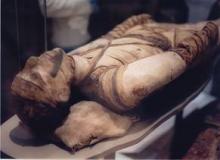Atherosclerosis may be an inherent part of aging and not so much the result of diet or lifestyle. At least that's what 4,000 years of human history told through mummies is showing.
The modern human's life expectancy has doubled over the past 200 years, and, during that time, atherosclerotic vascular disease has replaced infectious disease as the leading cause of death in the developed world, according to researchers. But when did this disease begin to leave its mark on human history? Is atherosclerosis the result of hours sitting behind a desk and eating fast food on the way home, or could it be a result of higher socioeconomic status? Or could atherosclerosis just be a disease of aging, having affected humans all along?
To find the answer, an international group of scientists selected 137 mummies from four different geographical regions. They called the study Horus, named after one of the oldest and most significant Egyptian deities. The scientists studied whole-body CT scans of 76 mummies from ancient Egypt, 51 from Peru, 5 Ancestral Puebloans of southwest America, and 5 Unangan mummies from the Aleutian Islands of modern day Alaska. The study results were presented at the annual meeting of the American College of Cardiology and published online March 10 in the Lancet (doi: 10.1016/SO140-6736(13)60598-X).
These hunter-gatherer-farmers not only lived in different parts of the world, and under different conditions, but also had a wide range of diets. For instance, while the Egyptians ate wheat, barley, beans, domesticated cattle, and quail, the Unangans mostly ate seafood.
After seven experienced cardiovascular imaging physicians interpreted the CT scans, looking for presence or absence of calcification in the vessel walls and the heart, they found that 34% of all the mummies had atherosclerosis – 38% of the ancient Egyptians, 25% of the ancient Peruvians, 40% of the Ancestral Peubloans, and 60% of the Unangans.
The findings also found that the older mummies had higher odds of atherosclerosis, and in a more severe form. The mean age of death for mummies with the vascular disease was 43 years old, compared with 32 years old for those without the disease (P less than 0.0001). Also, mummies with a mean age of 42 years had atherosclerosis in one or two vascular beds, while those with a mean age of 44 years old had the disease in three to five beds (P less than 0.0001).
So what does this mean for today's diet-obsessed society? "Our understanding of the causative factors of atherosclerosis is incomplete, and that atherosclerosis could be inherent to the process of human aging," wrote researchers, led by Dr. Randall C. Thompson of University of Missouri-Kansas City School of Medicine, Kansas City, MO.
The findings are also significant because previous research that had uncovered atherosclerosis in Egyptian mummies had proposed that the disease may have been due to higher socioeconomic status, and, hence, diets rich in saturated fat. "The fact that we found similar levels of atherosclerosis in all of the different cultures we studied, all of whom had very different lifestyles and diets, suggests that atherosclerosis may have been far more common in the ancient world than previously thought," said Dr. Thompson in a news release from the LANCET.
There are caveats and other variables to consider, of course.
For one, all the populations lived at a time when infection was a major cause of death. And, as found in modern humans, high level of chronic infection and inflammation might have promoted the inflammatory aspects of atherosclerosis, the authors noted.
Also, researchers used calcification as a marker of atherosclerosis, but didn't have pathological confirmation of the disease. "However, arterial calcifications on imaging studies in patients are deemed characteristic for clinical atherosclerosis," they wrote. In addition, the calcification occurred at the same location as in modern humans and appearance was the same.
The quality of soft tissue preservation varied among the mummies; some of the mummies, especially those from Egypt, had undergone artificial mummification, a process during which some of their vessels and organs had been removed.
The authors also acknowledged that their sample size represented a wide cross-section of four cultures, but lacked the "statistical power to adequately compare potential differences in the incidence and severity of atherosclerosis between men and women, and between different cultures."
However, the study has for the first time, shown that the disease was common in several ancient cultures so different from each other, and the "findings greatly increase the number of ancient people known to have atherosclerosis," the researchers wrote.

